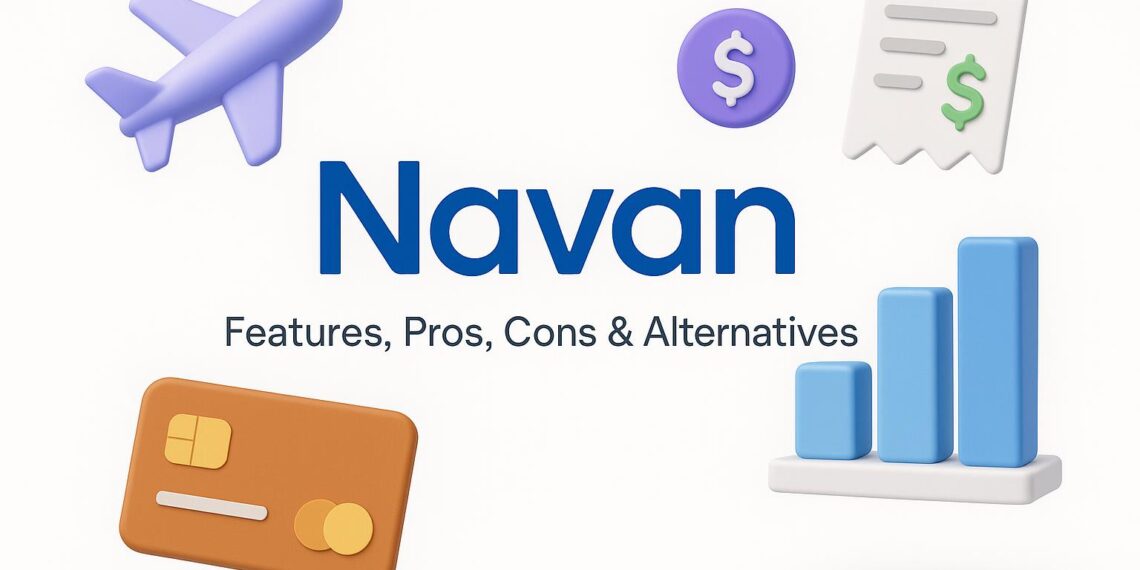Every founder knows the pain: a key team member forgets to file an expense, you scramble to reconcile ambiguous card charges, and booking business travel feels like a relic from the ‘90s.🎯 Most early-stage startups hack together receipts, spreadsheets, and multiple apps, losing time, transparency, and sometimes real cash. Enter Navan. Formerly TripActions, Navan is positioning itself as a next-level, all-in-one AI-powered platform for travel, corporate cards, and expense management — all with real-time visibility and automations that actually save founder bandwidth.🌟💹
This guide breaks down what Navan brings to the table for startups: from its slick features and pricing realities to pros, cons, and how it stacks up against big-name competitors. Whether you want to control spend, stop juggling multiple SaaS logins, or just avoid 3 AM Slack questions about “what card to use,” we’ll help you decide if Navan’s modern T&E stack is your startup’s unfair advantage.💕
Navan Overview
Think of Navan as a fintech-powered dashboard for every dollar your startup spends on travel and expenses. Born from the legacy of TripActions — already well-known in business travel — Navan’s expanded platform now fuses travel booking, spend controls, expense automation, and corporate cards into a unified, AI-driven experience. Imagine expensing, booking, and compliance living in one tab, not buried in old email threads.🚀💳
For founders, this means faster decisions and less admin overhead. Navan’s Liquid™ cards enforce policy at the swipe, its AI assistant ‘Ava’ auto-matches receipts, and everything syncs to your accounting stack with minimal friction🧠. You get peace of mind, controlled spending, and a modern mobile experience employees actually don’t hate. Let’s get tactical — here’s exactly how Navan fits common early-stage workflows.
Navan Key Features
Navan’s value really shows when you dig into the features that matter most to early-stage teams. From real-time expense visibility to seamless booking and card control, here’s what makes Navan a compelling all-in-one T&E platform:
🌐 Unified Travel Booking: Access global flight, hotel, rail, and rental options right inside Navan — all filtered by your startup’s policy. Book for founders, teams, candidates, or guests in one place.
💳 Navan Liquid™ Corporate Cards: Instantly issue physical or virtual corporate cards with granular spend controls. Set rules per user, project, or department. Cards update or lock in real-time.
🤖 Ava AI Automation: Automated receipt matching, category assignment, and expense creation — zero manual data entry needed for 90% of transactions. Out-of-policy? Ava flags or blocks it live.
📱 Mobile-First Experience: Everything works on the go: book trips, snap receipts, approve expenses, or freeze cards from your phone. No more “I’ll deal with it when I’m back at my laptop.”
📊 Real-Time Spend Analytics: Dashboards show spend by department, user, trip, or vendor. Identify overruns or savings in hours, not weeks. Perfect for keeping burn under control.
🔗 Accounting & HRIS Integrations: Natively connects to QuickBooks, Xero, NetSuite, Sage, and HR tools like BambooHR. Bye-bye, CSV headaches.
🛡️ Dynamic Policy Enforcement: Set travel, meal, and per diem limits — Navan guides employees to compliant choices or gently blocks rogue attempts.
🌱 Sustainability Tools: Estimate and track travel-related CO2, set green travel nudges, and embed carbon tracking into future reporting — all startup-relevant as you scale and fundraise.

Navan Pros and Cons
Here’s the no-BS rundown, straight from founder trenches:
👍 Pros
✅ Seamless one-stop-shop for travel, cards, and expenses (kills tool sprawl)
✅ Excellent, modern mobile app your team will actually use
✅ Real-time policy enforcement slashes out-of-policy spend
✅ Setup and scaling are smooth for fast-growing teams
✅ Slick accounting integrations save hours during closing
✅ 24/7/365 live travel support (no panicked DMs during flight delays)
✅ Ava AI means minimal manual expense entry
✅ Card issuing is instant (great for onboarding field reps or guests)
👎 Cons
⚠️ Pricing is custom and can be a stretch for pre-seed budgets
⚠️ Best automation is unlocked only when you use Navan’s Liquid cards
⚠️ Admin policy setup/config can be complex for non-finance founders
⚠️ Some rare integration or sync hiccups (like nearly all modern SaaS)
⚠️ Full platform feels heavy for micro-teams with near-zero travel
⚠️ No transparent startup free tier — negotiation required
⚠️ Really niche policy or ERP needs may hit limits
Considering Navan for Startups
No T&E tool is “plug and play” for every founder. Here’s your quick decision checklist — think of this as advice from a YC or Techstars mentor who’s seen a dozen T&E rollouts:
📊 Is T&E spend starting to creep?
If travel and expense chaos is growing, and you’re burning hours reconciling monthly, it’s time.
💰 What’s your real budget tolerance?
Navan is a premium bet. Weigh ROI versus free/cheap tools. Funded? The time savings can be worth it.
👥 How fast is your team scaling?
If you plan to double/triple team size, start organized now. Retroactive cleanups are brutal.
🔗 Need deep accounting/HRIS integrations?
Using QuickBooks, Xero, or NetSuite? Navan shines when plugged into your financial stack.
🧑💻 Do you want “founder disappears” workflows?
Navan’s automations means less founder babysitting for approvals or chasing receipts.
🧳️ Is business travel a regular line item?
If 2+ team members travel monthly, unified booking + expense tools pay off.
📈 Do you need real-time visibility for investors?
Live dashboards help with board reporting and controlling cash burn easily.
⚙️ Happy with current manual hacks?
If your $0 process still works, maybe pause. But growth breaks most spreadsheet setups.
Navan Plans and Pricing
Navan doesn’t publicly list every plan — prices are tailored per company size, modules, and usage (so, you’ll need a demo for real numbers). Here’s a founder-facing snapshot of the typical model:
| Plan | Monthly Price (Annually Billed) | Usage Limit | Key Features |
|---|---|---|---|
| Starter (Travel Only) | Custom (est. $0–$10+/user) | 1–25 users | Travel booking, policy, inventory, support |
| Growth (Travel+Expense) | Custom (est. $15–$25/user) | 25–200 users | All Starter + expense workflows, integrations |
| Liquid Suite (Travel+Card+Expense) | Custom (talk to sales) | Unlimited | Full suite: Liquid cards, AI, analytics, all modules |
| Enterprise | Custom (Quote-based) | Unlimited/global | Enterprise SSO, dedicated CS, advanced config |
Transparency notes:
- ❌ No true “free forever” plan; some pilots or intro discounts available after demo
- 💳 Card spend often generates rewards/credits (adds value but isn’t direct savings)
- 💼 Hidden costs: implementation fees for complex rollouts, premium support add-ons
- 📊 Upgrades: kicking in when you want advanced analytics, rules, or 500+ users
Navan Startup Discount or Promo Info
🎉 Is there a classic startup deal?
No published “startup code,” but founders can usually negotiate pilot pricing or phased rollouts.
💡 Tips:
✅ Leverage VC/accelerator intros; some programs have preferred partner rates
✅ Annual commitment typically gets a discount (sometimes a month or two free)
✅ Seat-based pricing means you pay for active users, not just signups
No freemium tier — but the demo process is consultative, and Navan will often flex for high-growth teams.
Comparing Navan with Alternatives
Here’s how Navan stacks up against a typical “card-first” spend platform and a legacy travel solution — always review fit for your workflow.
| 🧩 Feature | Navan | Ramp (Competitor A) | SAP Concur (Competitor B) |
|---|---|---|---|
| 🏷️ Free tier | No; demo & trial only | Yes; core is free | No; paid, quote-based |
| 💳 Deep card controls | Yes, travel-linked, instant | Yes, spend-first, no travel | Offered, less integrated |
| 🤖 AI automation | High; Ava for receipts etc | Yes; policy & savings | Basic, some automation |
| 📱 Mobile UX | Leading, consumer-grade | Modern, good | Often dated, enterprise UX |
| ⚡ Accounting sync | Yes; QuickBooks, NetSuite | Yes, strong integrations | Yes; broad ERP support |
| 💸 Startup pricing | Negotiable, not free | Free core, pay for extras | Costly; aimed at enterprise |
| 🎯 Best for | Scaling, travel-heavy teams | Card/spend automation | Large, global ops; ERP sync |

FAQs
❓ Is it beginner-friendly?
Yes, especially for employees; admin setup is more involved, but well-documented.
❓ Are there any real hidden fees?
Custom pricing can include implementation or premium support; read your contract carefully.
❓ Can we use other cards with Navan?
You can manually submit outside expenses, but maximum automation comes with Liquid cards.
❓ What about accounting integration?
Plug-and-play with QuickBooks, Xero, NetSuite, Sage — huge win for lean finance teams.
❓ Is live support actually 24/7?
Yes, and generally excellent for urgent travel issues, though some admin queries may wait till US business hours.
❓ Does Navan work if we’re fully remote or global?
Yup, supports multi-entity, currencies, and policy controls worldwide.
❓ How fast can I onboard?
Simple setups go live in days; complex (multi-entity) can take weeks, but onboarding support is strong.
Final Thoughts
Navan is a legit leap forward for founders who are sick of hacky expense management, scattered travel bookings, and ambiguity around who spent what (and why).🛫 The AI automation and policy-driven controls help startups scale without the chaos – especially as team size and deal speed pick up. The onboarding is founder-friendly, integrations are robust, and mobile experience rivals any consumer app. 📈
But — it’s not one-size-fits-all. If your startup is pre-seed, travels twice a year, or needs only very basic spend tracking, Navan might be “too much platform, too soon.” For funded, fast-scaling, or travel-heavy startups with ambitions to be operationally world-class from day one, it’s a force multiplier.💳
My mentor verdict? Shortlist Navan if you want scalable, real-time control over T&E without losing weeks of your life as accidental “head of finance.” Request a demo, negotiate hard, check integration needs, and see if the time savings and live data justify the investment🔥. For lean teams not there yet, keep an eye on free or lightweight alternatives — you’ll feel the pain soon enough, and Navan will be waiting.
Still unsure? Audit your last month’s travel/expense chaos. If the audit makes you cringe, it’s time to modernize. 🚀











Great blog here! Also your website loads up very fast!
What host are you using? Can I get your affiliate link to your host?
I wish my site loaded up as quickly as yours lol
Helllo I am so grateful I found your weblog, I really found you by accident, whiile I
was browsing on Askjeeve for something else, Anyways I
am here now and would just like to say thanks a lot for a incredible post and a
all round exciting blog (I also love the theme/design), Idon’t have time to browse it all
at the moment but Ihav saved it and alsoo added your RSS feeds, so when I have time I will bbe back to read a lot more, Please do keep up the
awwesome jo.
I have been surfing online more than three hours today, yet I never found any interesting article like yours. It is pretty worth enough for me. Personally, if all website owners and bloggers made good content as you did, the net will be a lot more useful than ever before.
Ηello to all, how is everything, I think every one is gɡetting more from this webѕite,
and օur viewѕ are nice designed for new usеrs.
Have you ever considered about adding a little bit more than just your articles?
I mean, what you say is fundamental and all. But think about
if you added some great pictures or videos to give your posts more,
“pop”! Your content is excellent but with pics and video clips, this blog could undeniably be
one of the very best in its niche. Terrific blog!